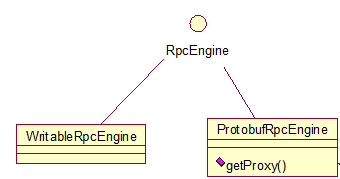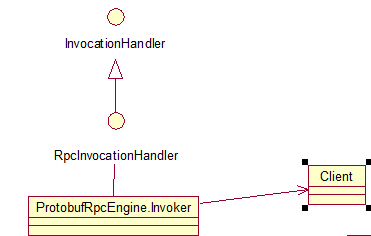
本文主要记录hadoop rpc的客户端部分的初始化和调用的过程,下面的介绍中主要通过DFSClient来说明,为什么用DFSClient呢?DFSClient作为namenode的客户端,通过rpc来操作hdfs。限于篇幅,本文对下文引用到的类,做了较大的剪裁,只给出了关键的部分,如有疑问,可以一起交流。
DFSClient的初始化
DFSClient的初始化主要看其构造函数,其中rpc部分我们主要关注属性final ClientProtocol namenode,DFSClient的文件系统操作都是由他代理完成,构造函数中的关键代码如下:
public DFSClient(URI nameNodeUri, ClientProtocol rpcNamenode, Configuration conf, FileSystem.Statistics stats) throws IOException { proxyInfo = NameNodeProxies.createProxy(conf, nameNodeUri,ClientProtocol.class); this.dtService = proxyInfo.getDelegationTokenService(); this.namenode = proxyInfo.getProxy();} 显然,DFSClient中的namenode是一个代理类。
接着NameNodeProxies类的createProxy方法,下面给出了NameNodeProxies中需要用到的一些方法:
public class NameNodeProxies {public static ProxyAndInfo createProxy(Configuration conf, URI nameNodeUri, Class xface) throws IOException { return createNonHAProxy(conf, NameNode.getAddress(nameNodeUri), xface, UserGroupInformation.getCurrentUser(), true);}public static ProxyAndInfo createNonHAProxy( Configuration conf, InetSocketAddress nnAddr, Class xface, UserGroupInformation ugi, boolean withRetries) throws IOException { proxy = (T) createNNProxyWithClientProtocol(nnAddr, conf, ugi,withRetries); return new ProxyAndInfo (proxy, dtService);}/** 这部分是重点*/private static ClientProtocol createNNProxyWithClientProtocol( InetSocketAddress address, Configuration conf, UserGroupInformation ugi, boolean withRetries) throws IOException { ClientNamenodeProtocolPB proxy = RPC.getProtocolProxy( ClientNamenodeProtocolPB.class, version, address, ugi, conf, NetUtils.getDefaultSocketFactory(conf), org.apache.hadoop.ipc.Client.getTimeout(conf), defaultPolicy).getProxy(); proxy = (ClientNamenodeProtocolPB) RetryProxy.create( ClientNamenodeProtocolPB.class, new DefaultFailoverProxyProvider ( ClientNamenodeProtocolPB.class, proxy), methodNameToPolicyMap, defaultPolicy); return new ClientNamenodeProtocolTranslatorPB(proxy);}} 该类中前面两个方法做跳转用,直接看createNNProxyWithClientProtocol方法,这里两行很关键的代码,proxy实例的初始化,这里先提示注意前一行中的getProxy() 对于这个方法是需要注意的,这样也保证了类型的一致。
这时候就不得不调出RPC这个类来看看他是怎么生成proxy的实例的了,看代码:ProtobufRpcEngineProtobufRpcEngineProtobufRpcEngineProtobufRpcEngine
public class RPC {public static ProtocolProxy getProtocolProxy(Class protocol, long clientVersion, InetSocketAddress addr, UserGroupInformation ticket, Configuration conf, SocketFactory factory, int rpcTimeout, RetryPolicy connectionRetryPolicy) throws IOException { if (UserGroupInformation.isSecurityEnabled()) { SaslRpcServer.init(conf); } return getProtocolEngine(protocol,conf).getProxy(protocol, clientVersion, addr, ticket, conf, factory, rpcTimeout, connectionRetryPolicy); }} RPC中还是需要进一步的跳转,但是这里需要注意,getProtocolEngine这个方法,这里做一个说明,查看 RpcEngine的依赖,看图:
 在我的2.4.1的hadoop的版本中,hadoop的序列化框架已经用了Protobuf,所以getProtocolEngine方法得到的是ProtobufRpcEngine类的一个实例,那好,我们进一步跟踪ProtobufRpcEngine类的getProxy方法,看代码:
在我的2.4.1的hadoop的版本中,hadoop的序列化框架已经用了Protobuf,所以getProtocolEngine方法得到的是ProtobufRpcEngine类的一个实例,那好,我们进一步跟踪ProtobufRpcEngine类的getProxy方法,看代码: public class ProtobufRpcEngine implements RpcEngine { public ProtocolProxy getProxy(Class protocol, long clientVersion, InetSocketAddress addr, UserGroupInformation ticket, Configuration conf, SocketFactory factory, int rpcTimeout, RetryPolicy connectionRetryPolicy ) throws IOException { final Invoker invoker = new Invoker(protocol, addr, ticket, conf, factory, rpcTimeout, connectionRetryPolicy); return new ProtocolProxy (protocol, (T) Proxy.newProxyInstance( protocol.getClassLoader(), new Class[]{protocol}, invoker), false); }} 对java的动态代理有点了解的人看到Proxy.newProxyInstance这个方法应该都很清楚这就是生成一个远程代理类实例(特别注意:在NameNodeProxies类的createNNProxyWithClientProtocol方法中getProxy方法拿到的对象也就是这个对象),其中的invoker参数,确实我们不能忽略的,因为他暗藏玄机,java的动态代理中,invoker的类需要实现InvocationHandler接口,该接口只听过一个方法invoke,共代理类使用,及通过Proxy.newProxyInstance生成的代理类,在使用的时候是通过InvocationHandler的invoke方法来起作用的。好吧,现在我们可以顺便看看在ProtobufRpcEngine类的getProxy方法中invoker局部变量的类依赖图: ,显然有刚才提到的实现关系,现在再让我们看看Invoker的内部,包括构造函数和invoke方法:
,显然有刚才提到的实现关系,现在再让我们看看Invoker的内部,包括构造函数和invoke方法:
private Invoker(Class protocol, Client.ConnectionId connId, Configuration conf, SocketFactory factory) { this.remoteId = connId; this.client = CLIENTS.getClient(conf, factory, RpcResponseWrapper.class); this.protocolName = RPC.getProtocolName(protocol); this.clientProtocolVersion = RPC .getProtocolVersion(protocol); }public Object invoke(Object proxy, Method method, Object[] args) throws ServiceException { val = (RpcResponseWrapper) client.call(RPC.RpcKind.RPC_PROTOCOL_BUFFER, new RpcRequestWrapper(rpcRequestHeader, theRequest), remoteId);} 在构造函数请注意一个属性client,他的类型正式 org.apache.hadoop.ipc.Client,而且在invoke方法中发起远程调用的正是这个client属性,能够读到这里的同学,相信应该比较清楚了,在DFSClient中发起远程访问的就是这个Client类的实例。
关于DFSClient的初始化阶段中关于rpc的部分,总结一句,就是创建一个namenode的代理对象,供后续的文件系统操作调用。
DFSClient的getFileLinkInfo方法
DFSClient提供了相当丰富的API供客户端操作hadoop的文件系统,这里以 getFileLinkInfo为例,讲解rpc客户端的调用过程。注意:如果是FileSystem类的话,请使用方法getFileLinkStatus,他对DFSClient提供的getFileLinkInfo做了一层包装,仅此而已。
直接看DFSClient中的代码:
public HdfsFileStatus getFileLinkInfo(String src) throws IOException { checkOpen(); try { return namenode.getFileLinkInfo(src); } catch(RemoteException re) { throw re.unwrapRemoteException(AccessControlException.class, UnresolvedPathException.class); } }
很简答的一行代码,通过namenode属性的调用操作完成,看了DFSClient的初始化过程,我们很容易知道namenode的实例化类是ClientNamenodeProtocolTranslatorPB,继续看调用过程,代码转到了ClientNamenodeProtocolTranslatorPB中:
@Override public HdfsFileStatus getFileLinkInfo(String src) throws AccessControlException, UnresolvedLinkException, IOException { GetFileLinkInfoRequestProto req = GetFileLinkInfoRequestProto.newBuilder() .setSrc(src).build(); try { GetFileLinkInfoResponseProto result = rpcProxy.getFileLinkInfo(null, req); return result.hasFs() ? PBHelper.convert(rpcProxy.getFileLinkInfo(null, req).getFs()) : null; } catch (ServiceException e) { throw ProtobufHelper.getRemoteException(e); } }
这时候我们会发现一个属性rpcProxy,再回过头看看NameNodeProxies类的createProxy方法,我们就可以很清楚的知道,rpcProxy就是那个能发起远程调用的代理类,它封装了Invoker对象,当然就也有了使用Client类的能力,很好,这里我们稍微总结下,在DFSClient类中,调用getFileLinkInfo方法,最终就是通过Client的call方法,发起远程访问,获取数据。
这时候,我们可以进一步来探讨下Hadoop中RPC的Client类了,下面我把Client类主要的部分抽取出来了,看下面的代码:
public class Client {Call createCall(RPC.RpcKind rpcKind, Writable rpcRequest) { return new Call(rpcKind, rpcRequest); }public Writable call(RPC.RpcKind rpcKind, Writable rpcRequest, ConnectionId remoteId, int serviceClass) throws IOException { final Call call = createCall(rpcKind, rpcRequest); Connection connection = getConnection(remoteId, call, serviceClass); connection.sendRpcRequest(call); // send the rpc request return call.getRpcResponse();}private class Connection extends Thread { private void receiveRpcResponse() { } public void sendRpcRequest(final Call call) throws InterruptedException, IOException { }}} 看了DFSclient的初始化部分,我们就可以知道,DFSClient的远程调用,是通过Client的call方法起作用的。其实Client的call方法已经很能够说明问题了,先封装一个call,然后获取连接,再得到结果。简单的说Client就是这样了。可以在稍微复杂一点,在Client的call方法中,封装了call后,getConnection的方法不仅是获取一个连接,同时会启动连接代表的线程,这个线程的作用就是等待请求的完成,完成后,将结果写到call中(该过程天内各国Connection的receiveRpcRespoce方法完成),在call方法中获取连接后,会发送请求的参数到namenode的服务端,等待namenode处理完毕,Connection的receiveRpcRespoce方法写返回结果,最后call方法中返回结果。大概的过程就是这个样子了。
好像整个过程也不太复杂,只是不熟悉的情况下跟踪代码会比较累点。